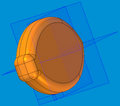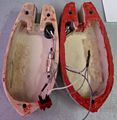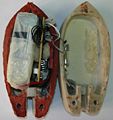ZOIDBERG - An autonomous bio-inspired Robotic fish
ZOIDBERG - An autonomous bio-inspired Robotic fish
| |
| Short Description: | ZOIDBERG is a project about an autonomous bio-inspired robot.
The project's aim is to realize a robotic fish actuated by a particular electroactive polymer of ICPF type (Ionic Conducting Polymer Film). |
| Coordinator: | GiuseppinaGini (gini@elet.polimi.it) |
| Tutor: | PaoloBelluco (belluco@elet.polimi.it) |
| Collaborator: | |
| Students: | FrancescoMilli (), MaurizioMercurio (), AlessandroNava () |
| Research Area: | Robotics |
| Research Topic: | Bio Robotics |
| Start: | 2007/03/18 |
| End: | 2008/10/14 |
| Status: | Closed |
| Level: | Ms |
| Type: | Thesis |
Part 1: project profile
Project name
ZOIDBERG - An autonomous bio-inspired robotic fish
Project short description
ZOIDBERG is a project about an autonomous bio-inspired robot. The project's aim is to realize a robotic fish actuated by a particular electroactive polymer of ICPF type (Ionic Conducting Polymer Film).
People involved
Project head
Prof.ssa Giuseppina Gini - User:GiuseppinaGini
Other Politecnico di Milano people
Ing. Paolo Belluco - User:PaoloBelluco
Students currently working on the project
Francesco Milli - User:FrancescoMilli
Maurizio Mercurio - User:MaurizioMercurio
Alessandro Nava - User:AlessandroNava
Laboratory work and risk analysis
Laboratory work for this project will be mainly performed at AIRLab/Lambrate. It will include significant amounts of mechanical work as well as of electrical and electronic activity. Potentially risky activities are the following:
- Use of mechanical tools. Standard safety measures described in Safety norms will be followed.
- Use of soldering iron. Standard safety measures described in Safety norms will be followed.
- Use of high-voltage circuits. Special gloves and a current limiter will be used.
- Robot testing. Standard safety measures described in Safety norms will be followed.
Part 2: project description
The project is composed by:
- State of the art;
- Preliminary studies and sketches;
- Design notes and guidelines;
- Description and results of experiments;
- Useful internet links: Dr. Zoidberg
State of the art
The work that mostly influenced the design of our robot is a lower-scale automaton realized by Shuxiang Guo, Yuya Okuda and Kinji Asaka, which is actuated with the same type of polymer that we used.
It is discussed in: ICPF Actuator-based Novel Type of Underwater Micro Biped Robot with Multi DOF
Preliminary part design
Mechanical structure
The design of the body has evolved into the current shape through many development steps, in response to the varying specifications of the on-board electronics, to changes in the manufacturing process of the hull, and for a better approach to the hydrostatic balance problem.
The first two images below represents the early proposed mostly flat design, and a step of the manufacturing of a "master" hull component in a modeling clay. The third image shows a simple prototype made of polyurethane foam, tethered to the tank for power supply. It can be noted the original configuration of the tail components, which were mounted in a horizontal fin arrangement with two parallel actuators.
Electronics
The first version of the on-board electronics was a two-boards arrangement. Due to problems and delays with the company responsible of the manufacturing of said boards, there are no working exemplars of this solution. In the meantime the circuit has been redesigned and simplified to fit a single board, and we put together a very simple intermittent circuit to carry the first autonomous tests (without the robot being tethered to the tank).
Below are shown, in order: the original schematics of the two boards, the schematic of the oscillator used for the first tests, based on a 555 chip, and the intermittent circuit assembled on a prototype board.
Videos of the actuator tests
Here are some clips, filmed during the first experiments trying to have a working actuator. The polymer and the electrodes are held in place by rough adhesive, and the power is supplied by an external generator. we are manually changing the polarity of the current going through the actuator.
Final design
(todo)
Tests and results
(todo)












